
© Ian Douglas. (Click image for larger version)
Souleymane Badolo with Cynthia Oliver
Boom!, Barack, and Buudou, Badoo, Badolo
New York, New York Live Arts
22 April 2013
NYLA bio page
www.newyorklivearts.org
Dance of Sadness
The nineteenth-century choreographer August Bournonville wrote of dance that it was “essentially an expression of joy, a desire to follow the rhythms of the music.” The body, especially when moving to the accompaniment of music, conveys this feeling of exultation, of momentary transcendence. This is paradoxically true even when the underlying feeling being expressed is something other than joy. Then, the audience experiences both emotions at once: the joy of the body in motion, colored by whatever emotion is being evoked through the choreography. The greater the dancer, the more stirring the joy. Or so I thought, until I saw Souleymane Badolo dancing two solos of his own making, Barack and Buudou, Badoo, Badolo, at New York Live Arts. Badolo, who was born and raised in Burkina Faso and who performed for several years in a company specializing in traditional African dance (DAMA), is a marvelously articulate, muscular, dancer. He dances with his whole body, his head, his feet, his back, his chest, even the tips of his fingers. His movements are full of detail and texture and sensuality, peppered with sudden changes of tempo and force. And yet, at least in these works, his dancing, though beautiful and sometimes outwardly euphoric, expresses almost no joy. It is as if it had been steeped in a deep sadness, a sadness that cannot be washed away. By dancing, he seems to will himself to pleasure. He never quite gets there.
The evening opened with a short work, Boom!, by another choreographer, Cynthia Oliver, a duet for herself and the younger Leslie Cuyjet. Both are African American, both play around with the truisms of the sassy, extroverted black woman, commenting on each other’s moves (“get it girl”) or dressing down an invisible partner (“I’m a rough you up! I’m a knock you down!”), all with a twinkle in the eye. As they go in and out of sync with each other, isolated gestures become movement phrases, often tinged with a Caribbean lilt. The leitmotif is the intimacy that can exist between two women; they love each other, even when they drive each other crazy. The two embrace for a long time, occasionally switching positions until these shifts, too, become dancerly motifs. It’s a slight piece, but not without charm.
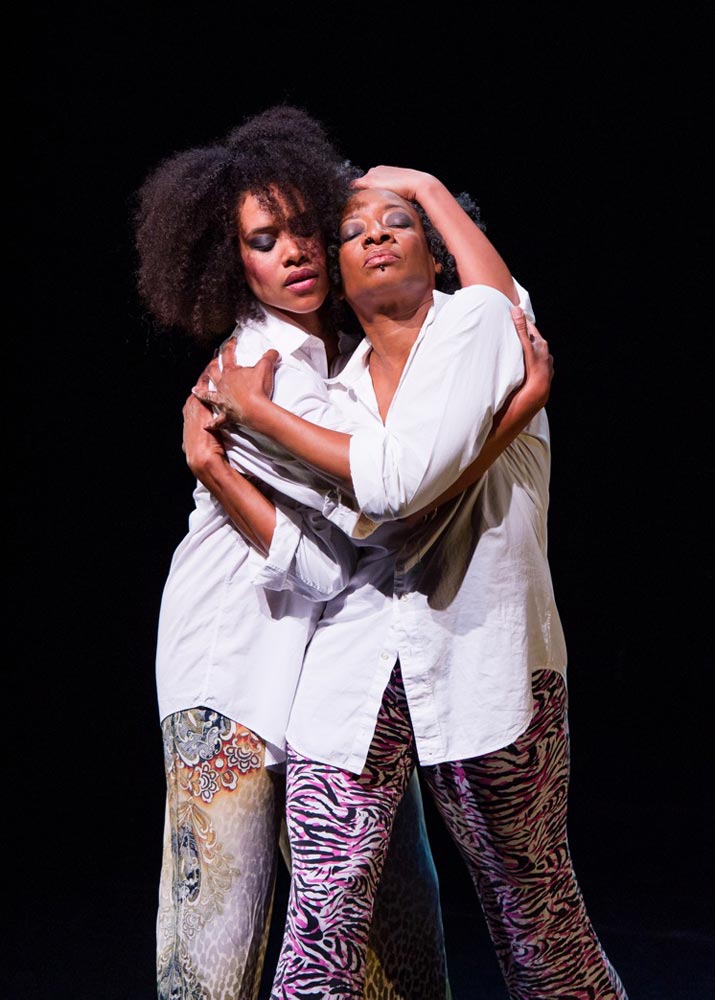
© Ian Douglas. (Click image for larger version)
Badolo writes in the program that Barack (which means “greeting” in his native language of Gurunsi) was conceived as an offering to his adopted country – the US – and the people who have helped him along the way. (He has lived here since 2009.) “What can I give to America?” he asks. But this “greeting” of his is not given lightly. He begins by bowing, slowly and ceremoniously, in an elegant fourth position, arms held out decorously almost in the manner of an eighteenth-century courtier. It’s a strange image; this compact, muscular man, wearing skin-tight, bright red trousers and a yellow hoodie, open at the chest, bowing slowly at center stage, then stage right, stage left. His face, especially his eyes, express total desolation. Then Edith Piaf’s powerful, rasping voice rings out: “Rien de rien, je ne regrette rien.” I regret nothing. Badolo moves his arms, powerful and vulnerable at once, fluttering, undulating them almost like wings, fingers trembling. It begins to look like a kind of idiosyncratic, private Dying Swan. “Je me fous du passé,” Piaf proclaims, almost angrily: “I don’t give a damn about the past.” But this dance is all about the past. Ripples pass through Badolo’s torso, he sweeps his arms, he rounds his muscular back; it is as if his personal history were passing through him. For a long time he hops on one leg, ducking and twisting his upper body, as if trying to keep a soccer ball in play. The song stops and he continues, now accompanied only by the sound of his own breathing. Remarkably, his movements – balances on the tips of his toes while leaning back, wild sweeps of the arms, jumps, hummingbird fingers – have a musicality of their own. One can see the African sources, which he has turned into a personal language, a vocabulary that, while not vast, never feels empty. He is fascinating to watch.
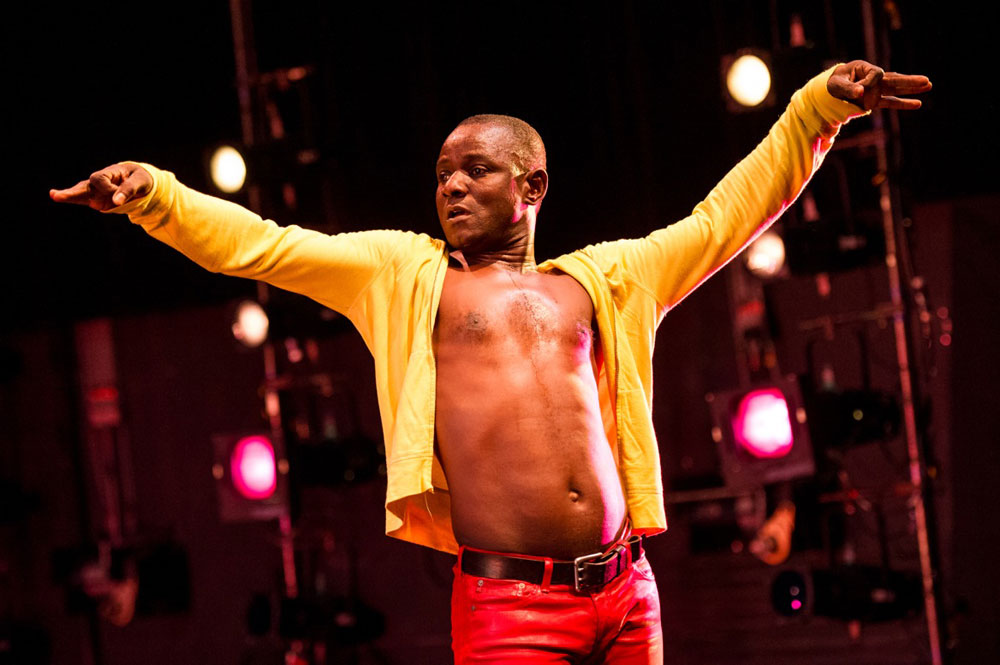
© Ian Douglas. (Click image for larger version)
Toward the end of the piece, an upbeat, syncopated song begins to play. The music is irresistible, made for dancing. It’s by Tabu Ley Rochereau, the Congolese afropop singer, known as “The Voice of Lightness.” Rochereau popularized soukous, a mix of Congolese folk, Cuban rumba, and American soul. Badolo begins to gyrate his hips, shake his shoulders, with his back to the audience. Finally, a kind of release. He turns around, and for a moment, a look of total despair crosses his face; he pulls at his skin, his chest. And then the shadow passes; he keeps dancing, as if willing himself to happiness. He embraces a woman in the audience, shakes another one’s hand, moves his behind very close to a man’s face. And then, suddenly, he’s gone. It’s an offering, but not one that comes easily.
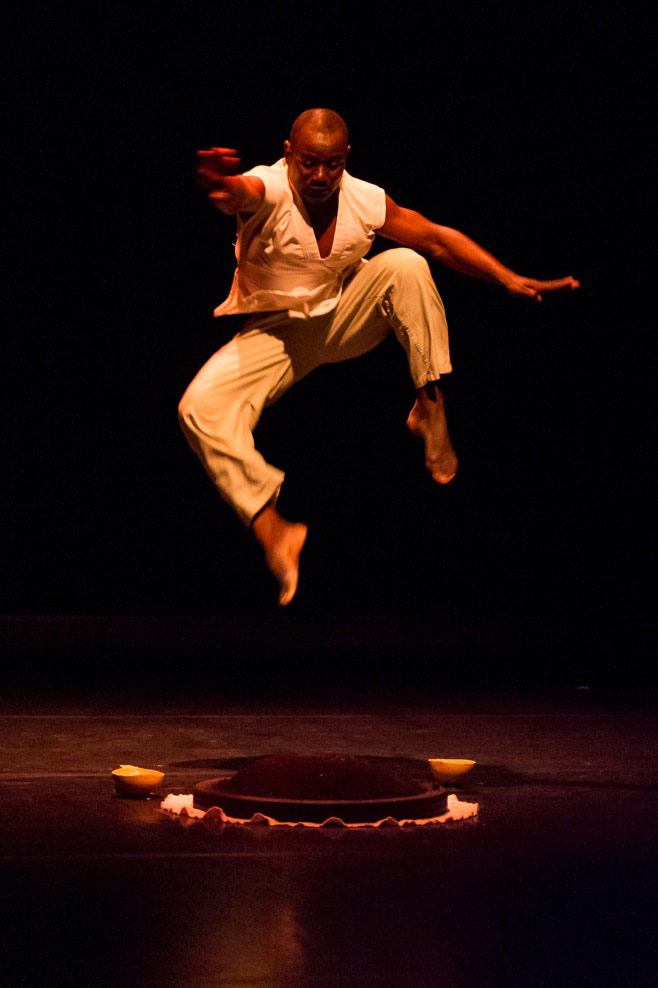
© Ian Douglas. (Click image for larger version)
Buudou, Badoo, Badolo is an offering of a different type, this one explicitly to the past, to his family and the world left behind for Bennington (in Vermont), where he now teaches. Specifically, it’s an evocation of the divination rituals of his ancestors. Most of it is performed in silence as Badolo travels from one small mound on the stage to another. A pile of feathers and fabric, a pan filled with rice, another containing a few dried beans. Almost blindly, he follows an internal map, often drifting backward into space as if pulled by an invisible force. Every so often he breaks into an ecstatic dance, arms slashing and slicing the air in arcs that stay on the retina because of the low lighting. For a long time he bends forward, head down, his back becoming almost an abstract landscape, a mass of muscles and flesh. He runs his fingers through the rice, moving it this way and that like beads on an abacus. He casts the beans, like dice, sometimes rubbing them against his head, and begins to speak in what I assume is Gurunsi. A disembodied voice responds from out of the darkness. The two men hold a private, almost internal dialogue, then come together, walking a circuitous path, hovering between the present and the past. As with the mask of white paint he wears at the end of the work, Badolo resists easy communication, holding back the natural expressivity of his body in order to seek out something more uncomfortable, just out of reach.












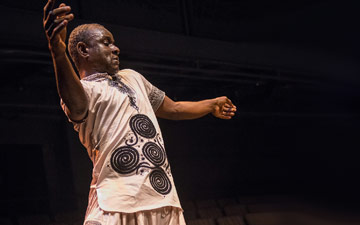

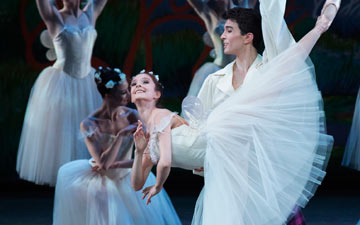


You must be logged in to post a comment.